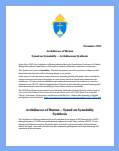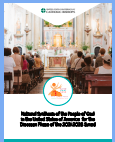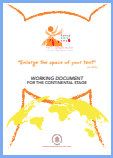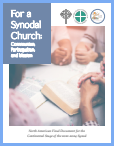The 2021-2024 Synod on Synodality
Since early in Christian history, Church leaders have sometimes convened councils called synods. The largest synods of the Church in the past two millennia are the 21 ecumenical councils, at which many bishops of the world have assembled, often in times of crisis, to hash out important issues facing the Church. Among the most influential of these synods were Nicaea (325), Chalcedon (451), Trent (three periods between 1545 and 1563), and Vatican II (1962-1965). Among the most influential regional synods in the first millennium of Christian were the councils of Edessa (197), Arles (313), and Orange II (529). As the Church became more centralized in the second millennium, such regional synods became rarer.
Since 1965, in the wake of Vatican II, popes have convened more than 25 synods of subsets of the world’s bishops for month-long advisory meetings. The topics of these synods have included peace and justice (1971), evangelization (1974), the Church in Africa (1994). Due to the relatively short length of each synod, most of these synods have been of limited scope and impact.
From the beginning of his pontificate in 2013, Pope Francis has been promoting the idea that the Church should be more synodal, or consultative, in how it operates. He has tried to expand the consultation process of the synods themselves. On October 2021, Francis called for a two-year Synod on Synodality, concluding in October 2023. The Vatican set out a consultative process, asking people around the world to meet in local parishes to respond to a series of questions.
- The Pastoral Council led the Paulist Center Community through 12 gatherings in the spring and summer of 2022 to solicit responses. Here’s a brief explainer that they used to define our goals during this process.
The parish responses were then summarized at the local level.
- Here is the 11-page summary we submitted to the Archdiocese of Boston in July 2022.
The parish responses were passed up to the dioceses, where they again were compiled and summarized.
- Here is a link to the Archdiocese of Boston’s summation report. (This is a redacted version to prevent the general public from identifying sexual abuse victims who shared vulnerably with the synod.).

These summations were sent to the regional bishops’ conferences. Those conferences in turn compiled and summarized the responses and sent them to the Vatican for a final compilation.
- The US Conference of Catholic Bishops’ National Synthesis was sent to the Vatican in September 2022.

As people around the world admitted, the first year of the synod was a messy, confusing, last-minute process. The Church had never attempted anything like this before, and the implementation plans varied from parish to parish, from diocese to diocese, and from region to region. Nevertheless, this is the most consultative process that the Church has attempted in its nearly 2,000-year history.
On October 2022, Francis announced that the Synod would be extended by another year, so that the Church could be more deliberate in processing and listening. The Vatican issued a working document that summarized the regional documents, with the intent of guiding people on each continent hrough further discussion of the topics surfaced from around the world.
- Here is the Vatican Working Document completed in October 2022.

Each continent recently produced another document, with a format specifically requested by the Vatican, in preparation for a month-long meeting in Rome of representatives around the world in October 2023.
- Here is the “North American” (Canada and the United States) final document of the continental phase, published in April 2023.

On April 26, 2023, Francis announced that, for the first time in modern history, 70 lay people (both women and men) would be voting delegates at the October 2023 meeting, still technically called a “synod of bishops.” This meeting will produce another document that will be promulgated for another year of discussion and study before a final month-long meeting in Rome in October 2024. On June 20, the Vatican released the instrumentum laboris (working document) for the October 2023 meeting. This is another extraordinary document in the history of the Church — presented not as a draft of what the October 2023 meeting will produce, but as a series of issues, questions, and worksheets.
What will come of this Synod on Synodality? It is understandable to approach this lengthy process with skepticism. (As it has been said, Jesus came to save the world, not to establish a committee.) But we should also approach it with hope that it will be guided by the Holy Spirit. Each of the documents above – with the exception of the initial explainer document – has expressed an openness and vulnerability in exploring the woundedness within the Church, including wounds caused by the Church itself. For example, contrast the October 2022 Vatican working document’s extensive discussion of women longing for leadership roles in the Church, with the Vatican’s May 1994 Ordinatio Sacerdotalis, which declared “the Church has no authority whatsoever to confer priestly ordination on women.”
It’s clear that the document resulting from the October 2024 meeting will have no authority unless it is received and implemented by Church leaders. It may take years, even decades, for the fruit of the Synod on Synodality to be realized. For example, the rule of thumb is that it takes 100 years to determine if an ecumenical council has been received by the Church. There’s a reason why most theologians would be pressed to name the resolutions of the 5th Lateran Council (1512-17), as its resolutions were mostly not received or implemented by the Church.